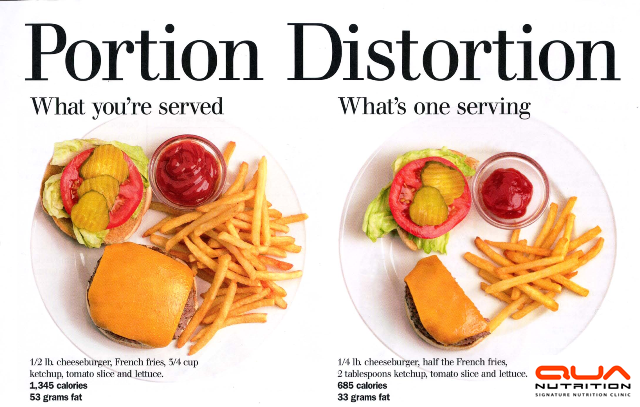Serving & Portion Control
A serving is a set amount of food that contains a specific quantity of calories and nutrients.
Servings normally are given in common units (cups, ounces, pieces, etc). For packaged food and drinks, the nutritional analysis is based on serving size found on the Nutrition Facts panel. You need to know a particular food’s serving size to tell how many servings you are consuming. People often have more than one serving at a time. To see how much fat, calories, etc. you really are taking in multiply all the numbers in the nutrition information by the number of servings you have.
Always look at the “servings per container” on the Nutrition Facts panel. Containers that seem to be a single serving such as a bottled beverage could have multiple servings. Be aware that a serving size on a manufacture’s label isn’t a recommendation of how much you should consume. But it does allow you to compare nutritional information of similar products.
A portion is the amount of food you choose to eat or the amount of food a restaurant gives you. It is not usually the same as a serving. Often, portions are larger than one serving. Large portions have been blamed for the increase in obesity in the United States. A key part of reaching or maintaining a healthy weight is portion control.

Our nutritionists at Physicians Weight Control & Wellness have curated these recommendations to help you manage your portion sizes and make healthier choices:
When Snacking, Consider measuring out a serving of your snack to familiarize yourself with the appropriate portion size. Avoid eating directly from the package; instead, place a small amount in a bowl. Opt for light ice cream bars over scooping from a gallon container to control portion size.
When Shopping, Invest 100% juice in individual containers that limit your portions to eight ounces. Choose light entrees that come in single-portion servings from the frozen food section. Purchase snack foods that are pre-divided into single servings to avoid overindulging.
When Eating Out, Steer clear of buffets where it’s easy to overeat. Request a takeaway container when ordering your food and promptly set aside a portion for later. Consider sharing your meal with a companion. Eat slowly to give your body time to register fullness.
When Getting Fast Food If possible, eat an apple before visiting a fast food restaurant to curb hunger. Steer clear of supersizing your meals. Consider ordering a kid’s meal, which often contains more appropriate portions. If you’re buying soda, use a small size and resist refilling the cup.
When Dining At Home, Begin your meal with a low-calorie, low-sodium soup to help fill you up. Use smaller plates to reduce portion sizes naturally. Keep serving bowls off the table to avoid mindless second helpings. Remember, “cleaning your plate” can be unhealthy if it’s overloaded with food.
How did your last weight loss plan go?
Our commitment to your well-being goes beyond helping you shed those extra pounds. We aim to guide you towards a lifestyle that celebrates health, vitality, and balance. Under the careful supervision of our expert team, Hormone Replacement Therapy can be a key component in this journey.